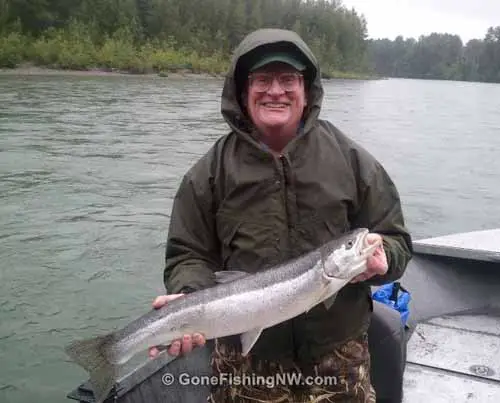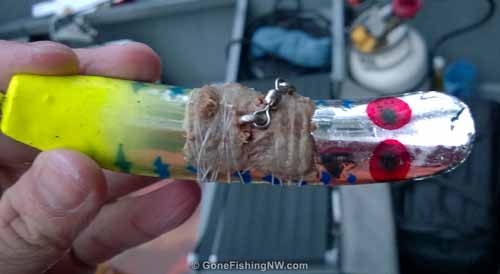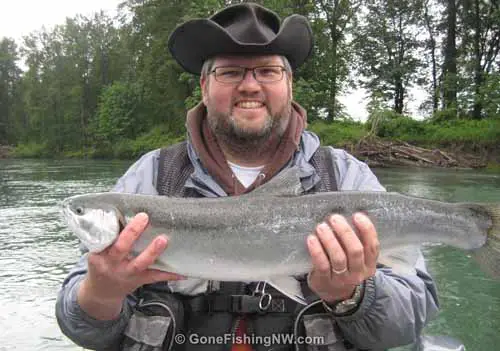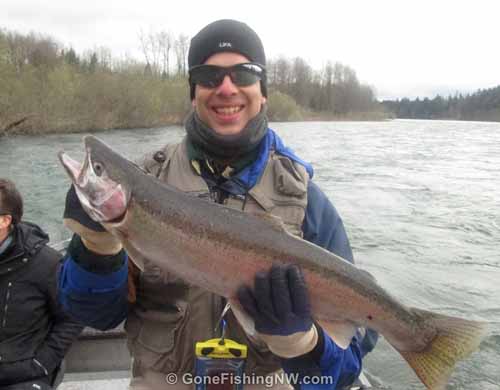Search
Latest Articles
Steelhead Plug Primer Part 2
by Nathan Nesbit of GoneFishingNW.com, December 29, 2016
Read The Water
A good place to start is typical steelhead water – that is water that is moving at a walking pace and is 4 to 8 feet deep. People are a little vague about what a walking pace is, but 2.5 MPH should be reasonably close.
Good places to work plugs include current seams, flats and tailouts.

If the water is high and fast, then the steelhead will typically be close to shore, and tight into structure, where the current is broken up and easier to stay in.
If water is low and clear, then we might find them in the deeper pools or slots and where riffles or structure let them hide.
Pick The Right Plug
Once we select what water we are going to fish, we can pick what plugs work best for that condition. The choice is largely going to be based on water depth, speed and clarity.
The guidelines we follow are:
* The plug should dive to the bottom of the river
* The plug needs to work in the speed of water, and even a bit slower
* The plug size and color need to match water visibility
* Metallic colors work best with sunlight, painted colors in low light conditions
In low and clear conditions we want small plugs in dull or natural colors. In murky or deep waters we will want larger plugs, in highly visible colors. For conditions in between we want plugs which are in between.
To Wrap or Not To Wrap
As with most fishing a bit of natural scent can enhance the effectiveness of artificial lures. Plugs are no exception.
One way to add scent is to put on a bait wrap. This is typically only done with banana style plugs. It is pretty easy to do, but may take some practice to deal easily. Trim the bait so it fits the plug and hold it centered around the belly hook. Then tightly wrap it with stretchy thread.

If you don’t have natural bait for a wrap, or are using a different style plug, then you can use a commercial scent. Shrimp, anise and crawdad are good scents to use.
Keep It Clean
If you use commercial scent or wraps, make sure to clean your plugs when you are done fishing. Otherwise that old scent will spoil on your lure – which is a turn off for fish. Cleaning your plugs is probably a good idea, even if you don’t apply a commercial scent – as they might pick up scents from the boat or fish that you catch.
I use WD-40 first to loosen the scent, then wash it in soapy water. Make sure to dry it off completely before putting it back in your tackle box.
Tune The Plug
Your plug needs to be in tune. When I first heard that I pictured a row of plugs all making noise in harmony together. What it really means is that the plug is working properly and running true.
You test your plug by running it in the water next to the boat.
If the plug travels off to one side, then it is out of tune. To fix it, take the plug out of the water. With a pair of needle nose pliers turn the screw eye on the plug. If the plug was running to the right, then turn the screw to the right. If it was running to the left, then turn it to the left. Often just a small adjustment is needed.
Don’t fish a plug until it successfully runs true. Otherwise its fish catching ability will be minimal.
Start Fishing
Now it is time to start fishing. With the plug in the water, let out about 40 to 50 feet of line. This is where a line counter or the metered line can really help.
The tip of the rod should vibrate due to the action of the lure. That wiggle lets you know that the lure is properly working. If that wiggle stops then something is interfering with the plug. Most of the time it will be a piece of debris, like a leaf, which has caught on the line or lure. It could also mean that the lure has gotten stuck under a rock or log.
When a fish strikes the lure it is usually quite savage. One second the rod will be sitting in the rod holder with the tip wiggling. The next the rod will be bent over, possibly peeling line as the fish fights.

Wall of Death
If multiple people are fishing from the boat, then you’ll have the most success forming a “wall of death.” This means running the plugs all the same distance from the back of the boat. When a steelhead encounters all those plugs, it will not be frustrated at not being able to get around them, and will strike them instead.
Backtrolling
You can keep the boat in the same place, usually with an anchor – waiting for fish to swim forward until they encounter your plugs. Or you can go “hunting” for them by back trolling.
Forward trolling is where the boat moves forward through the water. Back trolling is similar, only in this case the boat moves backwards, but at a slower speed than the current. This allows the current to work the plugs, while allowing the boat to cover different water.
You want to drift downstream at about half the speed of the current. However, it is best to take your time. Too slow is much better than too fast.
Backtroll all the way through the slot, run or pool. This is important as most strikes will happen in the last third of the run.

Using A Plug From Shore
If you are stuck on shore you may think there is no way you can plug fish for steelhead, and that techniques like backtrolling are the sole domain of those snobby boat fishermen. Lucky for those of us stuck on the bank we can use plugs too.
There are three primary ways that you can plug for steelhead from shore – with a side planer, back footing and plunking.
Plugs and Side Planers
Luhr Jensen sells a side planer called the Hot Shot Side Planer. It is no coincidence that this name matches that of their Hot Shot plugs. It is a side planer designed to be used to plug from shore.
Just follow the instructions Luhr Jensen publishes on how to set it up.
To fish it, first put the plug in the water and let out 30-40 feet of line. Wrap the line a couple times around the tab of the side planer – to hold it in place. Then let the current catch the planer and work it out towards the middle of the river.
At this point you are fishing. You can stay still and wait for the strike. Or you can SLOWLY walk downstream, keeping the line tight, to simulate backtrolling. When you have a fish on, the pressure will pull the line off the tab, and allow the planer to slide down the mainline.
Back Footing
I first heard of this technique from JD Richey. It works best on smaller steelhead streams, where you can wade to be directly above where you want to fish. Once in the water let out your plug 30 to 40 feet back. Then slowly start walking downstream. Remember to take is slow and watch your footing. You don’t want to fall in. Also be mindful of potential redds – gravel areas where fish lay their eggs. If we love fishing, then we need to treat fish with respect so we can continue to fish them in the future.
Plunking with Plugs
For those who like to plunk bait, you can also use plugs at the same time. You add a “stop” on your mainline about 18 inches above your plunking gear. This is usually a decent sized swivel. Bait and cast out like usual. Now take the plug you want to use and tie on a 2 or 3 foot leader. At the other end of the leader tie on a snap. Close the snap around the mainline, and let the plug drop into the current. As the current pulls the plug, it will start to dive and slide down your mainline. It will stop once it reaches that “stop”. Now you have both your plunking bait and plug fishing.
Conclusion
I hope you’ve found this article helpful, and wish you the best of success in your plug fishing.
Tight Lines!




